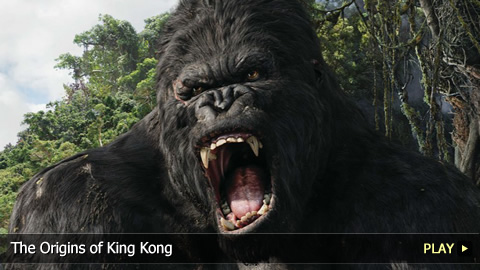The Origins of King Kong

Behold, the eighth Wonder of the World! Welcome to WatchMojo.com and today we’ll be taking a look at the origins of King Kong.
This large beast made his silver screen debut at New York’s Radio City Music Hall on March 2nd, 1933. American filmmaker Merian C. Cooper was originally motivated to create such a monster based on a dream he had in which a giant gorilla ransacked and frightened New York City.
Though audiences came to sympathize with Kong as an anti-hero, he was first envisioned as a “giant terror gorilla.” The director’s original intent was to take a film crew to the Congo to cast a real-life, wild gorilla in the role of Kong, and to have that beast fight an actual Komodo dragon. However, because of the Great Depression, that idea was scrapped.
Animal rights activists must have been happy when stop-motion animation was then adopted as the storytelling method. Though the film dropped the gorilla versus dragon concept, that idea did inspire Kong’s epic battle with a Tyrannosaurus Rex, without endangering any real animals. Funnily enough, the original Kong stop-motion model stood a mere 18-inches tall, and was covered in rabbit fur!
As explained in the mythology of the 1933 black-and-white film, the 50-foot-high King Kong was the last member of the “Megaprimatus Kong” species. He was given his name by the tribal natives of the mysterious Skull Island, and in fact he was just one of many other oversized creatures that resided on that island hidden deep in the Indian Ocean.
This aspect of the story was inspired by the “Lost World” genre of fiction, which was popularized in a number of novels that preceded “King Kong,” including Arthur Conan Doyle’s 1912 novel “The Lost World,” and Edgar Rice Burroughs’ 1918 novel “The Land that Time Forgot.”
The film’s plot revolved around an aspiring actress who was hired to make an exotic picture. After arriving at the film’s far-off shooting location, she was captured by the natives for use as a sacrifice to Kong. However, instead of eating her, the giant ape took her back to his lair and fell in love.
Following her rescue, Kong fiercely pursued her until he was subdued by gas grenades. His captors then took him back to New York City and marketed him as a wondrous exhibit. However, Kong freed himself, recaptured his love and in the film’s famous ending carried her to the top of the Empire State Building, where he met his fate.
“King Kong” proved to be an incredible spectacle for its time, and because of this it was blessed – and cursed – with several follow-ups. These included the immediate and less-than-memorable sequel “The Son of Kong,” where a younger Kong was found. Nearly three decades later in 1962, the ape jumped back to the big screen to battle Japan’s most legendary movie monster in “King Kong vs. Godzilla.”
By 1967, the Japanese made their own Kong film, entitled “King Kong Escapes.” In that feature, Kong faced off against several fictional monsters and a mechanical version of himself.
In 1976 Paramount Pictures finally decided to modernize the classic tale with a remake starring Jessica Lange as Kong’s object of affection, and Jeff Bridges as a primate paleontologist. Afterwards, Kong returned in 1986’s low-budget sequel “King Kong Lives,” where it was shown he survived his wounds, and awakened from a decade-long coma to meet “Lady Kong.”
It wasn’t until 2005 that director Peter Jackson was finally allowed to revive the beast. He unleashed a visually-stunning and faithful remake starring Naomi Watts and Jack Black, and made a box office killing in the process.
Movies aside, Kong has never spent much time away from the public consciousness. He’s popped up in countless other forms of media in some form, including comics, television and video games. He even served as the centerpiece of one of the most popular theme park rides ever created!
Beauty may have killed the beast, but King Kong remains alive and well, and continues to entertain us with his unique tale of tragic love… several decades after he first grabbed himself a busty blonde.
